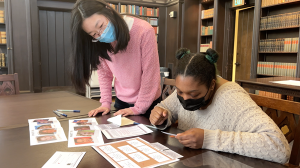3 The Euphorigen Investigation

WEEK 3: THE EUPHORIGEN INVESTIGATION
Overview:
This week we’ll begin the training needed to act as hosts for a puzzle solving game, The Euphorigen Investigation, one of our main means of educational outreach to our communities. The game provides an interactive learning opportunity about misinformation. It was developed by scientists and students at University of Washington’s Center for An Informed Public. The Euphorigen Investigation can be deployed entirely online through Zoom or in other formats. We hope to host this game for local public libraries and high schools. We will provide practice opportunities before then in our labs.
The activities below will help you review and rehearse before our practice. There are 2 parts to this week’s activities. It’s estimated you’ll need 6 hours to complete all of them.
Part 1 of 2 – PRACTICE HOSTING AN ESCAPE DISINFORMATION GAME
Objectives:
- Identify the learning goals behind the game.
- Set up an account to act as a game host.
- Review the support materials for the game.
- Practice leading the game with friends and family.
- Describe your experience leading the game and how we might help you when we start hosting real gaming sessions in the future.
- Explore one of the key topics of the game, faked and misused images and video.
Activities:
1. (30 min.) Watch an introductory video by the game’s creators, then answer the questions below:
-
-
- Why did the creators choose an escape room to teach about misinformation?
- What are the key objectives of the game?
- How do you think people will react to this gaming experience?
-
2. (60 min.) Create a Game Host log-in at Loki’s Loop. Note: Registration is not automatic. It may take TWO DAYS or longer for you to receive the confirmation email sent by members from the Center for an Informed Public with login instructions, so plan ahead. Once your account has been approved, log in and review the Game Host guide listed under Online Games Toolkit. Make note of any questions you may have about hosting the game for our lab meeting.
3. (2 hours) Create a New Online Game Session in the online portal. Then invite a couple of friends or family to participate in a practice game with you as host. Enlist a couple of people you know who are willing to go through the game with you as host. It’s likely to be a “rough and ready” experience, so be kind to yourself if it doesn’t go well. We’ve all been there, even if we’ve been teaching for years!
Describe how your game session went below. Include:
-
-
- How many people played the game, what challenges they (and YOU) encountered when playing the game
- What your game players thought of it at its completion
- What you think of the experience, and what you might need for support once we go live
-
Part 2 of 2 – FAKE & MISUSED IMAGES
Objectives:
- Examine the problem of faked and misused photos and videos
- Consider tools to help our communities identify false and misleading media..
Activities:
1. (60 min.) A faked video is one of the problems encountered in the Euphorigen Escape Room game. Let’s explore this issue a little further; watch this video on Evaluating Photos & Videos, then answer the questions below:
-
-
- What example does the video provide of a fairly recent altered image?
- What example does the video provide of an image taken out of context?
- What are 2 ways we can track down an image’s “origin story”?
- What is one suggested way to investigate a possibly “deep faked” video?
- How is this video related to the Lateral Reading resources we examined in Week 1?
- What are the implications of not evaluating the quality of information we encounter online according to the video?
-
2. (30 min.) Watch the video Deep Fakes are Becoming More Realistic Thanks to New Technology and respond to the questions below:
-
-
- What are the ethical implications of deep fakes?
- What are the potential positive uses of deep fakes?
- What do you think of the deep fakes of Tom Cruise, Ryan Reynolds or others on TikTok or other social media outlets? Do you think most people are aware that they’re fakes? If you’re unsure what I’m referring to you can read this article TikTok is Obsessed with This Hilarious Ryan Reynolds Lookalike.
-
3. (60 min.) Now try out an online site which tests the ability to recognize a faked photo. Test yourself with at least six sets of images on Which Face is Real. Then respond to the questions below:
-
-
- What tactics did you try to employ as you went through the images? Were they successful?
- Do you think this would be a useful resource for our communities? Why/why not?
- Do a search for additional resources related to fact checking images used online. Put a link to the resource below with a brief description as well as reasoning why you think it might be useful.
-

